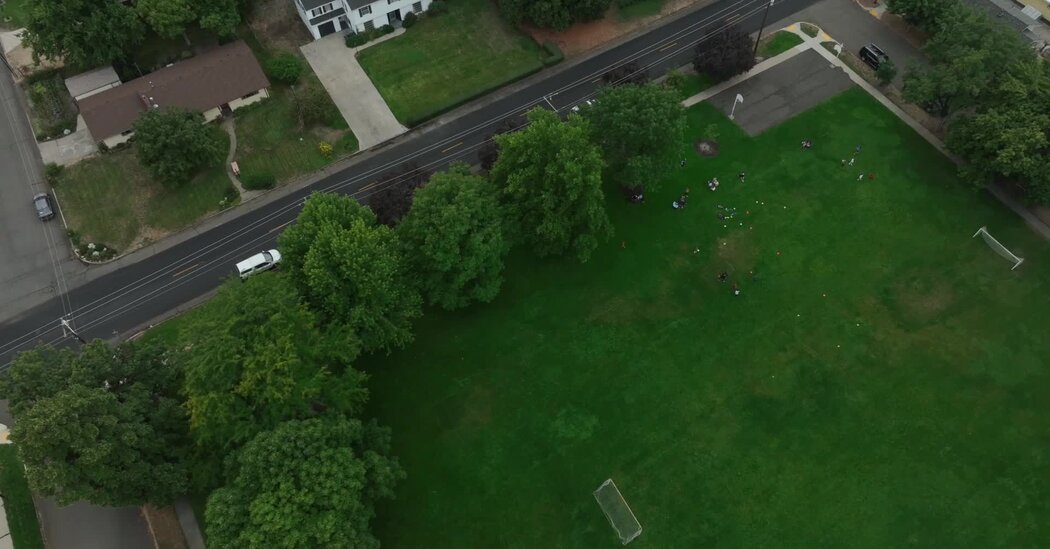Ghost stories can cast long shadows in a small town. Locals forget exactly why a certain area once seemed so foreboding, but the old fears linger, dredged up by neighbors and repeated by children who have only a hazy sense of the details.
Residents of La Grande, in eastern Oregon, know this all too well. They’re still haunted by a homicide that happened 42 years ago, known as the Candy Cane Park killing.
A cast of regulars was drinking one Saturday night in February 1983 at a dive called My Wife’s Place. La Grande was — still is — a place where everybody knows everybody, nobody is ever too far from a cousin or a classmate, so people at the bar that night had history. Romances, breakups, feuds. Two of them flirted and then squabbled. Around 3 a.m., after a quick stop at another nearby bar, the patrons made their way home.
A few hours later, around daybreak, the body of the bartender at My Wife’s Place, Dana DuMars, a bespectacled 21-year-old, was found in Candy Cane Park. She had been struck with a hatchet seven times.
The law enforcement investigation was flush with strange turns. The police interrogated one suspect and persuaded him he had magical powers, including by shining a light on his hands and suggesting the glow was caused by blood. The interrogating officer threw a card with Miranda rights written on it into the wastepaper basket. The suspect confessed. Three years later, the conviction was overturned.
For the next 42 years, local detectives picked up the case occasionally, but it remained unsolved, an object of nagging concern and fascination among locals.
Candy Cane Park, named for its red-and-white-striped swing set, was covered in “a decade-old veil of darkness,” an article in The La Grande Observer said in 1992. In the early 2000s, the town removed the merry-go-round from the park’s playground — partly because residents reported seeing ghosts spinning it violently, according to local lore.
“A wavering fragment of weirdness does linger,” the newspaper noted in 2015, revisiting the case.
Today, some kids still grow up hearing from their parents that they should avoid playing in the park.
“It was so out of our ordinary, and what you count on in a small town is kids being able to walk home from school,” said Tammy Jane Greenwell, 57, who was a student at La Grande High School, less than a mile from Candy Cane Park, when the murder happened. She remembers changing her route home from school to avoid passing the park. “I don’t think you go to that park as a member of our generation and it doesn’t cross your mind,” she said.
Mike Harris, an investigator for the district attorney’s office, is pretty sure he knows who committed the crime. He has spent years examining evidence and reconstructing the events of the hours around the murder. He has corresponded with Ms. DuMars’s daughter, who was surprised to hear the case might be solved.
But this April, something shifted. He was abruptly ordered to stop looking for clues in the Candy Cane Park killing.
The investigation, Mr. Harris said in an interview, is “dead in the water.”
Box of Evidence
The Union County district attorney, Kelsie McDaniel, is a registered independent whose office sofa has a Ruth Bader Ginsburg pillow nestled against a pillow with the flag of the so-called thin blue line, signaling support for law enforcement. She is ambitious about what a rural, small town district attorney’s office ought to do for its community. She calls her approach to the law “smart prosecution,” a balance between focusing on services — she started a mental health program for people involved with the local court — and accountability, prosecuting drug trafficking cases and homicides.
Federal grants have allowed Ms. McDaniel to view her agenda more expansively. With a grant of $148,833 from the Justice Department’s rural violent crime reduction initiative, given in 2023, she was able to hire her office’s first investigator. She chose Mr. Harris, who had worked across the street at the police department.
Mr. Harris, a laconic 54-year-old originally from Eureka, Calif., grew up in a family of law enforcement officers. His cousin was a sheriff and his uncle a road patrol deputy. When Mr. Harris reached his 30s, after years of working on ranches tending horses, he decided it was time for a more stable line of work. He became a reserve officer for the police department in Myrtle Creek, a small town in western Oregon.
When a full-time position opened in Baker City, he moved across the state, and in 2010 followed the police chief to La Grande. He liked that the town was tight-knit and slow-paced, home mostly to loggers, lumber mill workers, farmers and students at Eastern Oregon University.
The adrenaline attracted Mr. Harris to police work — the car chases, the gnawing uncertainty in a late-night shift. But over time, he realized that investigations satisfied him most. He loved the methodical process of reading court transcripts, and the “aha” moments when names and addresses and stray statements coalesced into a narrative. From the time he arrived in La Grande, one case in particular weighed on him: the Candy Cane Park killing.
“Why didn’t somebody figure this out sooner?” Mr. Harris recalled thinking. “People were around then, they remember it, they want answers.”
He was working for the La Grande Police Department around 2018 when a taxi driver named Patty Stroud died. Ms. Stroud, then 63, was acid-tongued, a keen dart player and a longtime resident of the area.
She also happened to be at the bar the night of the killing.
So Ms. Stroud’s death meant something urgent to the La Grande Police Department: a potential lead on the case of Candy Cane Park. The sergeant who first learned of her death called Mr. Harris. Mr. Harris wrote a search warrant for Ms. Stroud’s DNA, which was collected before she was cremated.
Ms. Stroud’s granddaughter did not respond to requests for comment.
Mr. Harris was still collecting evidence for the case years later when he joined the district attorney’s office. The new job first required him to jump into investigating fentanyl overdoses and gathering evidence for prosecuting cases of child and sexual abuse. He met with victims of domestic violence to make sure their restraining orders weren’t being violated. And whenever he could, he dug back into cold cases, especially Candy Cane Park.
Mr. Harris put together binders of documents to make sense of the case. He read more than 8,000 pages of police reports, diary entries and newspaper clippings.
He learned that on the night of the killing, Ms. Stroud and the man initially convicted, Bart Cochran, had an argument at the bar. Ms. Stroud had offered to drive a friend home around 3 a.m., but her pickup broke down on the way. She ended up walking, crossing past Candy Cane Park, where she spotted Ms. DuMars.
Ms. Stroud and Ms. DuMars had a turbulent history, according to Mr. Harris. Ms. DuMars had an ex-boyfriend who stopped by the bar that night, and who was described by friends as having violent tendencies. The former boyfriend had told Ms. DuMars he would kill her if she became romantically involved with his brother, according to Mr. Harris’s research. Ms. DuMars did just that, the investigator found.
Mr. Harris collected these strands of information, spreading papers across the corner of the office that he called his war room. At one point, he learned that a misplaced box of evidence had turned up in a locker at the police department.
When Mr. Harris sifted through the box, wearing latex gloves, he saw Ms. DuMars’s shoes in a brown paper bag, along with her ear muffs and maroon pantyhose. He found a rape kit and an envelope with the contents of her stomach from that night. He also found the hatchet, rusty and resting on Styrofoam in a box wrapped in red tape. Some of the evidence, he said, had been passed around among officers who weren’t wearing gloves.
That was only one part of the case’s mismanagement. Documents from the initial interrogation reveal that an officer tried to hypnotize Mr. Cochran into believing he had a “gift,” and could use it to intuit information about events he hadn’t observed.
“I hope it gets solved,” said Mr. Cochran, who still lives in La Grande. “That’s all I’ve got to say.”
Mr. Harris is infuriated by what he considers the shoddiness of that original investigation.
“The theory we operate on in investigations is to make sure your theory fits the facts,” he said. “Don’t make your facts fit the theory — which is basically what they did, in fixating on Mr. Cochran.
“The hatchet was found and they picked it up and passed it around — what are you thinking? They had rubber gloves in 1983. It was too late for Dana, but she’s got a family that deserves answers.”
He has tried to interview everyone who knew Ms. DuMars and those who were at the bar that February night in 1983. He sent off fingernail clippings from the crime scene, found in the evidence box, for DNA testing. (Once those results come back, he intends to send off Ms. Stroud’s DNA.)
Over time, while reading through his binders, something clicked. He settled on two potential suspects. It’s possible that one or the other did it, though Mr. Harris is “pretty sure they both were aware what was going to happen.”
But then he had to stop investigating.
Case Closed, for Now
On April 23, Mr. Harris was about to leave to visit his grandchildren in Wyoming when the district attorney’s office received an email from the Justice Department. It informed Ms. McDaniel that, as of April 22, her office had lost the funding that supported Mr. Harris’s position.
The Union County district attorney’s office, about 2,500 miles away from Washington, D.C., had become perhaps the most unlikely casualty of the Trump administration’s sweeping budget cuts last spring.
Major national and international programs were eliminated, affecting health and humanitarian aid, climate research, the arts and the State and Justice Departments. Somewhere in there was Mr. Harris’s job, and his investigation into the Candy Cane Park killing.
“You’ve got to be kidding me,” Ms. McDaniel recalled thinking at the time.
“It seemed really like a backhand slap to us,” she said. She kept asking her staff, “Does Mike still work here?”
When Mr. Harris returned to the office after his trip, he texted his colleague: “Do I still have a job?” (The office moved him to a different role, which doesn’t allow him to do investigations.)
The Justice Department’s cuts in April to local law enforcement support added up to some 373 grants totaling hundreds of millions of dollars. In a rural community like La Grande, and in an office of about 10 people like Ms. McDaniel’s, the cuts landed like heavy blows.
“The grant that I was working under was very specifically a rural violent crime grant,” Mr. Harris said. “We’re pretty rural and murder is pretty violent.”
The Candy Cane Park investigation was a small part of the work that Ms. McDaniel’s office did. But it had a strangely personal resonance for Ms. McDaniel and Mr. Harris. After nearly half a century, people in the community want closure. Their wait will continue.
But Mr. Harris hasn’t given up entirely.
“When I sink my teeth into something, I don’t let go,” he said.
He and Ms. McDaniel recently learned about a Justice Department grant for cold cases. They intend to apply. Ms. McDaniel called their nearby crime lab asking about the DNA test from the Candy Cane Park-related evidence sent years ago, hoping that if those results come through, it might bolster their chances of getting new funding.
“This case is very solvable,” Mr. Harris said recently. “It’s a matter of getting the stars aligned.”
Susan C. Beachy and Kitty Bennett contributed research.
Emma Goldberg is a business reporter covering workplace culture and the ways work is evolving in a time of social and technological change.
The post The Candy Cane Park Murder Was Almost Solved. But Then … appeared first on New York Times.




